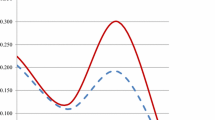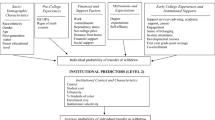Abstract
Little research has been conducted on multiple-transfer students, those students who transfer more than once during their collegiate careers. In this study, background characteristics and previous interinstitutional movements of a sample of multiple transfers enrolled at a large, urban, public university were examined. These students moved along four different transfer paths before enrolling at the university, where they comprised one-fifth of new undergraduate enrollments. Their paths differed significantly on a number of demographic, institutional, and interaction variables. Overall, these students were academic achievers with high socioeconomic status backgrounds, who focused on academic quality and programs in choosing four-year colleges. Their tendency to transfer among large, inexpensive, public institutions has negative implications for the private sector of higher education.
Similar content being viewed by others
References
Astin, A. W. (1971).Predicting Academic Performance in College. New York: The Free Press (American Council on Education).
Astin, A. W. (1975).Preventing Students from Dropping Out. San Francisco: Jossey-Bass.
Astin, A. W., Korn, W., and Green, K. (1987, Winter). Retaining and satisfying students.Educational Record, pp. 36–42.
Beal, P. E., and Noel, L. (1980).What Works in Student Retention. Iowa City: American College Testing Program and the National Center for Higher Education Management Systems.
Bean, J. P. (1982). Conceptual models of student attrition: How theory can help the institutional researcher. In E. T. Pascarella (ed.),Studying Student Attrition (pp. 17–33). San Francisco: Jossey-Bass.
Becker, J. (1988). An analysis of the search stage of the college choice process undertaken by community college transfer students.Dissertation Abstracts International 9: DA8817928.
Carnegie Foundation for the Advancement of Teaching (1986). The price of shaping students' choices.Change 18(3): 27–30.
Carnegie Foundation for the Advancement of Teaching (1987).A Classification of Institutions of Higher Education. Princeton, NJ: Princeton University Press.
Carroll, C. D. (1989).College Persistence and Degree Attainment for 1980 High School Graduates: Hazards for Transfers, Stopouts, and Part-timers. Washington, DC: U.S. Department of Education, Office of Educational Research and Improvement.
Chapman, D. W. (1981). A model of student college choice.Journal of Higher Education 52(5): 490–505.
Cope, R., and Hannah, W. (1975).Revolving College Doors: The Causes of Dropping Out, Stopping Out, and Transferring. New York: John Wiley and Sons.
Davis, J. S., and Van Dusen, W. D. (1975).A Survey of Student Values and Choices: A Pilot Study of the Relationships of Student Values, Perceptions, and Choices of Institutions. New York: The College Entrance Examination Board.
Dillman, D. A. (1978).Mail and Telephone Surveys: The Total Design Method. New York: John Wiley & Sons.
Getzlaf, S. B., Sedlacek, C. M., Kearney, K. A., and Blackwell, J. M. (1984). Two types of voluntary undergraduate attrition: Application of Tinto's model.Research in Higher Education 20(3): 257–268.
Hackman, J. R., and Dysinger, W. S. (1970). Commitment to college as a factor in student attrition.Sociology of Education 43(3): 311–324.
Hearn, J. C. (1984). The relative roles of academic, ascribed and socioeconomic characteristics in college destinations.Sociology of Education 57: 22–30.
Holmstrom, E. I., and Bisconti, A. S. (1974).Transfer from Junior to Senior Colleges. Washington, DC: American Council on Education, Office of Research. ERIC Document ED 093422.
Hossler, D. (1984).Enrollment Management: An Integrated Approach. New York: The College Board.
Hossler, D., and Gallagher, K. S. (1987). Studying student college choice: A three-phase model and the implications for policymakers.College and University 62(3): 207–221.
Johnson, N. T. (1987, July). Academic factors that affect transfer student persistence.Journal of College Student Personnel, pp. 323–329.
Jones, J. C., and Lee, B. S. (1992). Moving on: A cooperative study of student transfer.Research in Higher Education 33(1): 125–140.
Knoell, D. M., and Medsker, L. L. (1965).From Junior to Senior College: A National Study of the Transfer Student. Washington, DC: American Council on Education. ERIC Document ED 013632.
Kotler, P., and Fox, K. (1985).Strategic Marketing for Educational Institutions. Englewood Cliffs, NJ: Prentice-Hall.
Lee, V. E., and Frank, A. F. (1990). Students' characteristics that facilitate the transfer from two-year to four-year colleges.Sociology of Education 63(3): 178–193.
Lenning, O. T. (1982). Variable-selection and measurement concerns. In E. T. Pascarella (ed.),Studying Student Attrition (pp. 35–53). San Francisco: Jossey-Bass.
Lenning, O., Beal, P., and Sauer, K. (1980).Retention and Attrition: Evidence for Action and Research. Boulder, CO: National Center for Higher Education Management Systems.
Manski, C. F., and Wise, D. A. (1983).College Choice in America. Cambridge, MA: Harvard University Press.
Metzner, B. S., and Bean, J. P. (1987). The estimation of a conceptual model of nontraditional undergraduate student attrition.Research in Higher Education 27(1): 15–38.
Noel, L., Levitz, R., Saluri, D., and Associates (1987).Increasing Student Retention. San Francisco: Jossey-Bass.
Pascarella, E., and Terenzini, P. T. (1980). Predicting freshman persistence and voluntary dropout decisions from a theoretical model.Journal of Higher Education 51(1): 60–75.
Pascarella, E., and Terenzini, P. T. (1983). Predicting voluntary freshman year persistence/withdrawal behavior in a residential university: A path analytic validation of Tinto's model.Journal of Educational Psychology 75(2): 215–226.
Peng, S. S. (1977).Transfer Students in Institutions of Higher Education. Washington, DC: National Center for Education Statistics (NCES 77-250).
Porter, O. F. (1989).Undergraduate Completion and Persistence at Four-Year Colleges and Universities: Completers, Persisters, Stopouts, and Dropouts. Washington, DC: The National Institute of Independent Colleges and Universities.
Richardson, R. C., and Bender, L. W. (1987).Fostering Minority Access and Achievement in Higher Education: The Role of Urban Community Colleges and Universities. San Francisco: Jossey-Bass.
Smith, N. (1987). An examination of factors and other related characteristics of community college students who transfer to selected senior institutions in California.Dissertation Abstracts International 48: DA8725048.
Tinto, V. (1975). Dropout from higher education: A theoretical synthesis of recent research.Review of Educational Research 45: 89–125.
Tinto, V. (1987).Leaving College: Rethinking the Causes and Cures of Student Attrition. Chicago: The University of Chicago Press.
University of Illinois at Chicago Office of Data Resources (1989).Survey of 1989 Transfer Students and Survey of 1989 Freshman Class. Unpublished study.
U.S. Department of Education (1986, November).Completion Time for Bachelor's Degrees. Washington, DC: Center for Education Statistics, Office of Research and Improvement.
U.S. News and World Report (1989).America s Best Colleges 1990. Washington DC.
Velez, W. (1985). Finishing college: The effects of college type.Sociology of Education 58: 191–200.
Velez, W., and Javalgi, R. G. (1987). Two-year college to four-year college: The likelihood of transfer.American Journal of Education 96: 81–94.
Williams, T. E. (1984). Recruiting graduates: Understanding student-institution fit. In D. Hossler (ed.).Enrollment Management: An Integrated Approach. New York: The College Board.
Willingham, W. W., and Findyikan, N. (1969).Patterns of Admission for Transfer Students. New York: The College Board.
Wisner, R. E. (1984). A longitudinal study of individual and environmental factors associated with student persistence at a public commuter university.Dissertation Abstracts International 45: 8412283.
Zemsky, R., and Oedel, P. (1983).The Structure of College Choice. New York: College Entrance Examination Board.
Author information
Authors and Affiliations
Rights and permissions
About this article
Cite this article
Kearney, G.W., Townsend, B.K. & Kearney, T.J. Multiple-transfer students in a public urban university: Background characteristics and interinstitutional movements. Res High Educ 36, 323–344 (1995). https://doi.org/10.1007/BF02208314
Issue Date:
DOI: https://doi.org/10.1007/BF02208314




